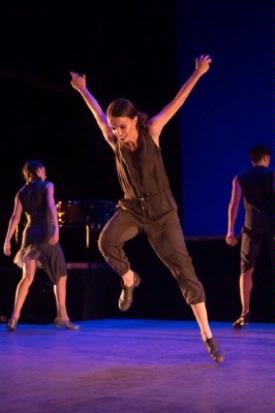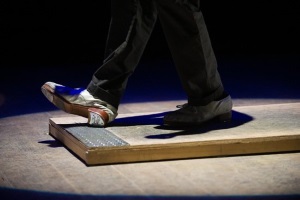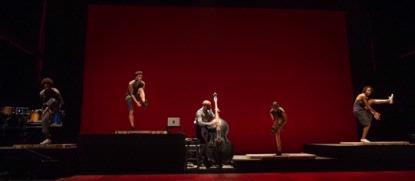“Tap predates jazz,” explained Michelle Dorrance when introducing an informal showcase of work by her students at Jacob’s Pillow earlier this summer. That is, before the blue note came the shoe note. But Dorrance is no strict preservationist – quite the contrary. Steeped as she is in the history and conventions of “America’s most longstanding indigenous jazz vernacular,” she is actively expanding its boundaries, fashioning a kaleidoscopic diversity of styles and traditions.
At that showcase in the Pillow’s Inside/Out series, the international group of students demonstrated a pyrotechnic array of steps and styles, all tap-rooted but embracing a worldwide field of forms, from classic shuffles and flaps to a polyrhythmic mode from South India and climaxing in a head-spinning tour through multiple time signatures.
The class, part of the dance festival’s summer training program, preceded a two-week run of the new work by Dorrance’s own tap troupe. It was titled “ETM: The Initial Approach” – ETM standing for “electronic tap music,” a play on EDM, electronic dance music, with the subtitle indicating its experimental nature. In contrast to last summer’s acoustic collaboration by Dorrance Dance with blueswoman Toshi Reagon, a soulful exploration of tap’s ancestral roots, ETM pushed tap forcefully into the future.
It was co-created by Dorrance and Nicholas Van Young, the dancer/choreographer/tech-wizard who fashioned the sensored percussion pads on the platforms that spanned the stage. These, tapped by the dancers’ feet, issued musical notes. Triggered in rhythmic order, they created melodies, and the rhythmic act of triggering created dance steps. The effect was fascinating – the dancers pulling the music into being and, simultaneously, the very act of music-making generating the dance steps. As my partner remarked, quoting Yeats’ rhetorical question, “How can we know the dancer from the dance?”


But that techno/human interaction might have seemed a mere party trick were it not for the performers’ thrilling technique, their embodied delight in the dance, and the program’s eclectic variety. There were solos, groups and duets – the latter including a sweet, supple whole-body pas de deux, performed to Adele’s song “First Love.” There was percussion, generated not just electronically but, in one case, in a drum duet, and in another, via the slither and crump of heavy chains dropped to the floor to produce a slouchy rhythm.
Each performer – and they were an eclectic bunch in themselves, hardly a conventional dancer’s shape or stance among them – had at least one solo improvisational moment to strut their specialties. Among these was guest artist Ephrat “Bounce” Asherie, a b-girl, who also appeared at the Pillow earlier this summer in the Unreal Hip-Hop revue, whose footwear was hightops and whose break-based moves not only stretched the show’s stylistic frontiers but served as a kind of parallel sign-language, a visual counterpoint to tap’s aural clatter.
Dorrance herself did a few solo turns, along with a song-and-dance duet with another guest artist, vocalist Aaron Marcellus, whose heavenly pipes and stunning range underscored – no, soared over – the last third of the program, often singing two- and three-part harmony with himself via digital looping. Instrumentalist Greg Richardson used the same looping technique at times, laying down a continuo on double bass then overdubbing it on electric guitar to create a backing track for the dancers’ foot music.
In the end, that organic/electronic, percussive/melodic fusion, the multilayered, polyrhythmic sequences, and the performers’ palpable joy in performing them, made this show one of the highest of this summer’s highlights.

Photos by Christopher Duggan
If you’d like to be notified of future posts, email StageStruck@crocker.com


